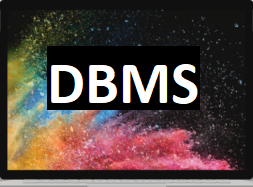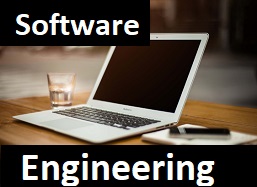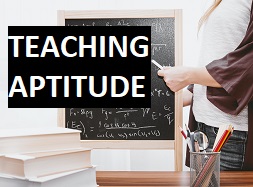
Q.1
Which of the following is the key teaching behavior to make a teacher effective?
(1) Teachers’ comments made for the purpose of organizing upcoming teaching process
(2) Use of content or process questions by teacher
(3) Engagement of students in the learning process
(4) Using student’s ideas and contributions
Answer : option 3
Q.2
The basic requirements for organizing teaching at reflective level deal with
(1) Systematic and sequential presentation of facts and information by the teacher
(2) Helping explore and explain problems and their solutions by students
(3) Translating and interpreting the facts by the students
(4) Giving concrete facts and action sequences by the teacher
Answer : option 2
Q.3
Identify the factors affecting teaching related to positive learning environment in an institution:
(i) The extent to which teachers make clear presentation
(ii) The scope for sharing and open discussions within the classroom and the institution as such
(iii) Teacher’s mastery of the content as reflected in answering students’ questions
(iv) Frequent use of positive reinforces either in the institution or classroom
(v) Availability of teacher and his/her guidance
Choose the correct answer from the options given below :
(1) (i) and (iii)
(2) (ii) and (iii)
(3) (iv) and (v)
(4) (ii) and (iv)
Answer : option 4
Q.4 In the following list. which belong to the category of learner-centered approaches?
(i) SWAYAM
(ii) Computer-aided instruction
(iii) MOOCS
(iv) Quizzes
(v) Buzz-sessions
Select the correct answer from the options given below :
(1) (i) and (iii)
(2) (ii) and (iii)
(3) (ii) and (iv)
(4) (iii) and (v)
Answer : option 1
Q.5
In the following two sets. set I mentions the evaluation system while set II gives their descriptive features. Match the two sets
set I set II
(Evaluation system) (Descriptive features)
(a) Formative evaluation (i) Comparing the students’ performance with that of others
(b) Summative evaluation (ii) Indicating standards of mastery
(c) Norm-referenced testing (iii) Diagnosing students’ problems
(d) Criterion-referenced testing (iv) Identifying scope for improvement
(v) Judging learning standards
Choose the correct answer from the options given below:
(1) (a)-(iv). (b)-(v). (c)-(i). (d)-(ii)
(2) (a)-(i). (b)-(iii), (c)-(iii). (d)-(iv)
(3) (a)-(iii). (b)-(iv), (c)-(ii). (d)-(i)
(4) (a)-(ii). (b)-(iii). (c)-(v). (d)-(iv)
Answer : option 1
Q.6
Which of the following sequences correctly reflects scientific investigation?
(1) Conceptualization. theorizing. deduced consequences. observation and testing
(2) Testing, observation, conceptualizing. theorizing and deduced consequences
(3) Theorizing. deducing consequences. testing. observing and conceptualizing
(4) Observation. conceptualization. theorizing. deduced consequences and method to verify them
Answer : option 4
Q.7
In a research problem ‘studying the effect of Teaching Methods on the Scholastic
Achievement of boys and girls in terms of their socio-economic background’. which can be
designated as independent variable?
(1) Scholastic achievement (2) Teaching methods
(3) Gender (4) Socio-economic background
Answer : option 2
Q.8
When results obtained in a research study can be extended to a group larger than the sample (outside the context of the study) it is called
(1) Internal validity (2) Functional relationship
(3) External validity (4) Hypothetical construct
Answer : option 3
Q.9
In a thesis “Format and styles of referencing’ have been inappropriately followed. this is an example of
(1) Technical lapse on the part of researcher
(2) Unethical practice of the researcher
(3) Inability of the researcher to write a thesis
(4) Lack of commitment on the part of researcher to write a thesis
Answer : option 1
Q.10
A university department plans to undertake a study wherein attitudes, values and biases of teachers and students are to be probed with an eye on disclosing their patterns of adjustment. Which types of research methods will be considered appropriate in this context?
(i) Experimental method
(ii) Case study method
(iii) Descriptive method
(iv) Ethnographic method
(v) Historical method
Select the correct answer from the options given below :
(1) (i) and (ii) (2) (ii) and (iii)
(3) (iii) and (v) (4) (ii) and (iv)
Answer : option 4
Q.11
Dynamics of good classroom communication involves :
(a) Indifference
(b) Motivation
(c) Being organized
(d) Exclusivity
(e) Participation
(f) Gendered views
Choose the correct option from the following:
(1) (a). (b) and (c) (2) (b). (c) and (d)
(3) (b). (c) and (e) (4) (c). (e) and (f)
Answer : option 3
Q .12
Instructional communication in the distance education mode is
(1) unstructured (2) self-regulatory
(3) informal (4) structured and interactive
Answer : option 4
Q.13 A teacher tells his students — “When you learn this. you will be able to carry out your project’. What does this communication suggest?
(1) Continued interest (2) Ambiguous advice
(3) Potential threat (4) Positive reinforcement
Answer : option 4
Q.14
The principles of effective writing useful for both students and teachers are
(a) Stress on hyperboles
(b) Liberal use of adjectives
(c) Clarity
(d) Conciseness
(e) Correctness
(f) Use of complex sentences
Choose the correct option from the following:
(1) (a). (b) and (c) (2) (b). (c) and (d)
(3) (c). (d) and (e) (4) (d). (e) and (f)
Answer : option 3
Q.15
Given below are two statements — One is labelled as Assertion (A) and the other is labelled as Reason (R):
Assertion (A): Communication does not include all human behavior for exchange of
information
Reasons (R): Communication involves the use of all five senses
Choose the correct option from the following:
(1) Both (A) and (R) are true and (R) is the correct explanation of (A)
(2) Both (A) and (R) are true but (R) is not the correct explanation of (A)
(3) (A) is true. but (R) is false
(4) (A) is false. but (R) is true
Answer : option 4
Q.16
Two numbers are in the ratio 3:7. If 8 is added to both the numbers. their ratio becomes 5:9.The numbers are
(1) 12,28 (2) 6,14
(3) 15. 35 (4) 24,56
Answer : option 1
Q .17
The number X in the following series:
3, 8, 18, 38, X, … is
(1) 78 (2) 80
(3) 76 (4) 74
Answer : option 1
Q.18
If ‘SOLUTION is ‘R5KTSH5M then ‘CROME’ will be written as
(1) BQ5HL (2) B5QLH
(3) BQ5LD (4) BS5LH
Answer : option 3
Q.19
If ‘a’ is inversely proportional to ‘b’ and ‘b’ is inversely proportional to ‘c’. then
(1) ‘a’ is inversely proportional to ‘c’ (2) ‘a’ is directly proportional to ‘c’
(3) ‘a’ is constant (4) ‘a’ is directly proportional to ‘bc’
Answer : option 2
Q.20
A sum of Rs. 2.000 yields Rs. 180 with simple interest in nine (9) months. The annual rate of interest is
(1) 9% (2) 10%
(3) 11% (4) 12%
Answer : option 4
Q.21
A fallacy in which an opponent’s position is depicted as being more extreme or unreasonable
than is justified by what was actually asserted is called
1) Argumentum ad Baculum (2) The Red Herring
(3) Argumentum ad Hominem (4) Straw Man
Answer : option 4
Q.22
The distinction between Savikalpaka (determinate) and Nirvikalpaka (indeterminate) is made with respect to which of the following pramanas?
(1) Anumana (inference) (2) Pratyaksa (perception)
(3) Arthapatti (postulation) (4) Upamdana
(comparison)
Answer : option 2
Q .23
The term “Paksa’ according to classical Indian school of logic refers to which of the following
terms in the process of inference?
(1) Major term (2) Undefined term
(3) Minor term (4) Middle term
Answer : option 3
Q . 24
Which of the following refers to an attribute of every categorical proposition which is determined by whether the proposition affirms or denies class inclusion?
(1) Quality (2) Quantity
(3) Distribution (4) Comparison
Answer: option 1
Q. 25
Question Number : 25 Question Id : 615475795
The product of any three consecutive integers is divisible by 6. Therefore, 3 x 4 x 5 (=60), is divisible by 6? Which type of reasoning is embodied here?
(1) Deductive Reasoning (2) Inductive Reasoning
(3) Non-verbal Reasoning (4) Abductive Reasoning
Answer : option 1
Q . 26
Directions Q. 26-30: The following table gives the percentage (%) of people having
knowledge of different programming languages. Assuming that the total number of people having knowledge about programming language is 12.00.000. answer the questions that follow the table:
| Programming Language | % of People having knowledge |
| C++ | 15% |
| C | 25% |
| COBOL | 12% |
| FORTRAN | 13% |
| JAVA | 15% |
| LISP | 10% |
| PYTHON | 10% |
The ratio of the number of people having knowledge about C to that of knowledge about
Java is
(1) 3:5 (2) 5:3
(3) 1:1 (4) 5:2
Answer : option 2
Q. 27
How many people have knowledge about C language?
(1) 1,80,000 (2) 3,00,000
(3) 1.56,000 (4) 1.44,000
Answer : option 2
Q. 28
The total number of people having knowledge about C. Java and COBOL is
(1) 4,80,000 (2) 5,04,000
(3) 5,16,000 (4) 6,24,000
Answer : option 4
Q. 29
What is the average percentage (%) of people having knowledge of programming language —Python. LISP and Java?
(1) 1.04% (2) 11.7%
(3) 26.6% (4) 11.0%
Answer : option 2
Q.30
Difference in the number of people having knowledge of C and COBOL programming languages is
(1) 1.20,000 (2) 1,80,000
(3) 1.44,000 (4) 1.56,000
Answer : option 4
Q.31
Consider the following storage devices :
(a) Hard disc
(b) CD-ROM
(c) DVD-ROM
Arrange these in ascending order of storage capacity and select the correct option :
(1) (b). (c). (a)
(2) (b). (a). (c)
(3) (c). (b). (a)
(4) (a). (c). (b)
Answer : option 1
Q. 32
Which of the following is a Decision Support System’ for assisting people in taking best decisions for their children’s future?
(1) E-Pathshala
(2) Saransh
(3) Shaala Sidhdhi
(4) SWAYAM PRABHA
Which of the following is a Decision Support System’ for assisting people in taking best decisions for their children’s future?
(1) E-Pathshala
(2) Saransh
(3) Shaala Sidhdhi
(4) SWAYAM PRABHA
Which of the following is a Decision Support System’ for assisting people in taking best decisions for their children’s future?
(1) E-Pathshala
(2) Saransh
(3) Shaala Sidhdhi
(4) SWAYAM PRABHA
(4) SWAYAM PRABHA
Answer : option 2
Q.33
Which of the following is NOT suitable in the context of E-mail?
(1) It is a letter sent over a computer network
(2) It can be used to send unsolicited messages
(3) E-mail is snail-mail
(4) E-mail address includes domain name
Answer : option 3
Q. 34
Match List I with List II:
List I List II
(E-initiatives) (Descriptions)
- Vidwan (i)Repository for full-text thesis,e-books and journals
- Digilocker (ii)Education portal to facilitate learning
- Sakshat (iii)Database of leading scientists/researchers
- Shodh Ganga (iv)Platform for issuance and verification of documents and certificates
Choose the correct answer from the options given below :
1) (a)-(i), (b)-(iii), (c)-(iv), (d)-(ii)
2) (a)-(iii),(b)-(iv), (c)-(ii). (d)-(i)
3) (a)-(iv),(b)-(ii), (c)-(i). (d)-(iii)
4) (a)-(ii). (b)-(i), (c)-(iii). (d)-(iv)
Answer :option 2
Q.35
In computer related activities. what is the full form of ‘WORM?
(1) Write On Random Memory
(2) Write On Real Memory
(3) Write Once Read Many
(4) Write Once Read Memory
Answer : option 3
Q.36
The Government of India has set up the Ministry of Jal Shakti by merging/renaming which of the following:
(1) Ministry of Water Resources and Ministry of Earth Sciences
(2) Ministry of Water Resources: Ministry of River Development and Ganga
Rejuvenation: and Ministry of Rural Development
(3) Ministry of Water Resources: Ministry of River Development and Ganga
Rejuvenation: and Ministry of Drinking Water and Sanitation
(4) Ministry of Water Resources
Answer : option 3
Q.37
Identify environmental issues which are local in nature:
(i) Depletion of ozone layer
(ii) Lake pollution
(iii) Soil erosion
(iv) Climate change
(v) Water logging
(vi) Solid Waste Management
Select the answer from the options given below:
(1) (ii). (iii). (v) and (vi) (2) (iii). (iv). (v) and (vi)
(3) (ii). (iii). (iv) and (v) (4) (i). (ii). (iii) and (iv)
Answer : option 1
Q.38
Which of the following UN Conferences/Summit adopted the program of Action for
Sustainable Development?
(1) Stockholm Conference (2) Rio de Janeiro Conference
(3) Johannesburg Summit (4) Ahmedabad Conference
Which of the following UN Conferences/Summit adopted the program of Action for Sustainable Development?
(1) Stockholm Conference (2) Rio de Janeiro Conference
(3) Johannesburg Summit (4) Ahmadabad Conference
answer : option 2
Q. 39
Which of the following indicates the objective of the United Nations Framework Convention on Climate Change (UNFCCC)?
(1) To stabilize greenhouse gases concentration in the atmosphere
(2) To prescribe limits on greenhouse gas emissions for individual countries
(3) To lay down enforcement mechanisms
(4) To prepare guidelines for formulation of Climate Action Plan by member countries
Answer : option 1
Q.40
For encouraging worldwide awareness and action for the protection of our environment.
UNEP focused on the World Environment Day (2019) on which of the following themes?
(1) Conserve energy (2) Tackle climate change
(3) Beat air pollution (4) Save water
Answer : option 3
Q.41
The Ancient Indian University known as the chief center for advanced and specialized studies in Nyava or Logic was
(1) Jagaddala University (2) Mithila University
(3) Nadia University (4) Valabhi University
answer : option 2
Q.42
Which items in the following constitute the non-conventional learning programs?
i) Tea sommelier
(ii) Oriental languages
(iii) Spa management
(iv) Museology
(v) Comparative languages
Select the correct answer from the options given below:
(1) (i). (ii) and (iv) (2) (i). (iii) and (v)
(3) (i). (iii) and (iv) (4) (ii). (iv) and (v)
Answer : option 3
Q.43
Which one of the following is a non-statutory body?
(1) National Council for Teacher Education (NCTE)
(2) Bar Council of India (BCI)
(3) Rehabilitation Council of India (RCI)
(4) National Assessment and Accreditation Council (NAAC)
Answer : option 4
Q.44
Which one of the following has been the basis for introduction of yoga in teacher training courses?
(1) National Policy of Education — 1968
(2) National Policy on Education — 1986
(3) Vision of Teacher Education in India : Quality and Regulatory Perspective — 2012
(4) Draft National Education Policy — 2019
Answer :option 2
Q.45
Identify the “NITI Aayog — Three Year Action Agenda Items’ related to the field of Higher Education:
(i) Autonomy for top colleges
(ii) Reform of the regulatory system
iii) Establishing a system of project and scholar-specific research grants
(iv) Promotion of research culture
(v) National Research Foundation
Select correct answer from the options given below:
(1) (i), (ii) and (iii) (2) (ii), (iii) and (iv)
(3) (iii), (iv) and (v) (4) (iv), (i) and (ii)
Answer :option 1
Read the passage carefully and answer questions that follow:
Political ‘representation’ nonetheless is the vehicle that enabled the re-introduction of “democracy” into the modern, practical political vernacular. The resulting liberal democracy does not directly descend from the ancient Athenian democracy. Between the eras virtually nothing existed that approached “democracy” as an actual or named political form and when it again became a focus of politics and theory. it was wedded to representation —so that what we call a democracy is, in fact, a distinctive kind of democracy, “a representative democracy” – While elections and popular pressure surely have political impact, the actions of representatives are the primary, official mechanism for translating democratic citizenship into political power. We rely on the representative process to promote political goodness in democratic society. But when one imagines the idea of representation these days, its association with ethics or goodness does not spring to mind. It is an impersonal process, after all— a mechanical method by which one entity stands for or re-presents another, politically required by the need to channel the judgements of millions of citizens into the legally authoritative hands of a small number of public representatives, or even the sentiments of thousands into the leadership of single person.
Which of the following implies the characteristic of modern political vernacular?
(1) Populist politics (2) Absence of structure
(3) Ethical discourse (4) Representativeness
Answer :option 4
Q.47
The political representation enabled the emergence of
(1) Athenian democracy (2) Liberal democracy
(3) Actual democracy (4) Theoretical democracy
Answer : option 2
Q.48
According to the passage actions of political representatives’ manifest
(1) Political will (2) Popular pressure
(3) Political power (4) Self-effacing behavior
Answer : option 3
Q. 49
According to the author. the idea of democracy is viewed as
(1) Ethical politics (2) Goodness of representation
(3) A representative process (4) Channelizing views of a few people
Answer : option 3
Q. 50
What is the perception of the author with regard to representational democracy?
(1) Legal as well as ethical
(2) Universal participation
(3) Arbitrarily authoritative
(4) Centralization of power in a few individuals
Answer :option 4




